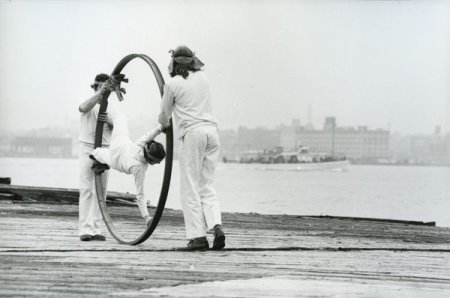
Joan Jonas, Mirage 1976 performance at the Anthology Film Archives, New York, 1976. Photo: Babette Mangolte © 1976 Babette Mangolte.
On a wintry Sunday afternoon last month, I leant against a railing overlooking the Thames—three down from Joan Jonas and her poodle, Ozu—to watch a reenactment of the American artist’s 1972 work Delay Delay. The performance was running 15 minutes late due to high tide, so that by the time it started two French women had half squeezed themselves into the non-gap between me and my neighbour’s right elbow. It wasn’t a surprise that it was crowded. Performance is experiencing a resurgence in popularity, and Jonas is one of its pioneering figures. Tate Modern’s retrospective of the artist—of which this reenactment is a part—is not only the largest exhibition of her work in the UK, but it is also presents one of the increasingly rare opportunities to see the 82-year-old artist perform. Even more enticingly, each time Jonas re-performs an existing work, she changes it, making every performance a new and unique occurrence.
Jonas is of the school of thought that performance is ephemeral and that what happens in the original performance is unrepeatable. Delay Delay was hence adapted to enable it to be performed on the Thames, resulting in Delay Delay (London Version) (2018), which is loosely based on three of Jonas’s outdoor pieces: Jones Beach Piece (1970), Nova Scotia Beach Dance (1971) and Delay Delay (1972). Not every artist changes their performances like this, and it is only possible for Jonas as her works are not strictly choreographed or scored. They remain open to reconfiguration even after they have been presented, meaning that each time a work is re-performed a new work is made.

Joan Jonas, Delay Delay, 1972, performance, Lower West Side, New York, NY, 1972. Photo by Gianfranco Gorgoni © 2018 Joan Jonas
This continual cycle of performance and reinvention, gives Jonas’ works a narrative. It highlights that artworks aren’t isolated occurrences, but part of a wider, ongoing dialogue, that involves the other artworks an artist makes, the texts they write, the research they do…their practice. And while this term is generally used to mean the ways that an artist goes about their work as an artist, its literal definition—as a repeated exercise in an activity or skill, that is undertaken to acquire proficiency in it—applies here too. Jonas is an artist who is constantly revising and revisiting her earlier artworks and ideas, not only for exhibitions and retrospectives, but as a valid form of artistic production. Ideas are honed over months, years, one artwork or three. A repeat performance can make something ephemeral visible again, just as it can play out a possibility that wasn’t explored first time around.
Consequently, Jonas never considers her works finished. They resist finalised form to occupy a middle ground between new and existing works—while they are not new in the sense that they have been produced now or recently for the first time, they do differ from the original work in content, material, and in the case of Delay Delay, title. They are contemporary versions of historic works, embodying the authenticity of the original, as well as the allure and novelty of the new.
This way of working originated in the conceptual and minimalist art of the late 1960s and early 1970s. In 1969 artist Robert Morris wrote that: “the notion that work is an irreversible process ending in a static icon-object no longer has much relevance” (R. Morris, Art Forum, 1969). Conceptual art, Minimalism and Process art, he said, had attacked the idea that: “art is a form of work that results in a finished product,” and had created “mutable stuff which need not arrive at a point of being finalised with respect to either time or space” (Morris, 1969). This was exemplified by the artist’s 1969 installation Continuous Project Altered Daily, which saw him arrange and rearrange an amalgamation of earth, water, paper, grease, plastic and wood on the floor of Leo Castelli’s warehouse in New York. By changing the installation every day for twenty days, he asserted that the art-object was a process and not a product. In doing so he devalued it—a durational and performative artwork is not one that is easily bought and sold.

Robert Morris, Continuous Project Altered Daily, 1969. Earth, water, paper, grease, plastic. Courtesy of Robert Morris and Marian Goodman Gallery, New York. © 2010 Robert Morris/Artists Rights Society (ARS), New York.
What is interesting is that these same qualities are marketable today. Live, mutable and/or immersive artworks appeal to audiences eager for experiences rather than things, and spectacular images that they can circulate online. This is due to the so-called “experience economy”. The term, coined by B. Joseph Pine II and James H. Gilmore in an article published in 1998 of the same title, refers to the business of selling personalised interactive events, so that memory itself becomes the product rather than a material good (Degen, Financial times, 2009). Rather than charging customers for differentiated commodities, goods, or services performed, the experience economy charges customers for the feeling they retain from engaging with a particular business. Jonas’ performances exemplify this, offering a live, unmediated encounter with the artist and/or the performers.
This is significant, as Jonas did make films based on many of her performances. In fact, on show as part of Tate’s retrospective is Songdelay, a film based on Delay Delay that Jonas made in 1973. In an interview with Art 21 in 2015, the artist attributed her desire to make films as a way to counter performance’s ephemerality, saying: “I was very interested in film and how to translate my work into another medium so that it would not disappear” (J.Jonas, Art 21, 2015). As Jonas states, filming her works has made them more permanent and accessible. However, the experience of watching a film and a live performance is incomparable. While both offer experiences of the work, one is reproducible, and the other, unique. In this light performance’s greatest limitation—its irreproducibility—is its greatest advantage in the experience economy. The medium offers an unrepeatable experience, especially when the artist, like Jonas, changes the work each time it is presented.
There is accordingly, an urgency to perform Jonas’ works now, as it is unknown how many performances remain. As many of the works are contingent on the artist’s direction, or her physical presence, they have a limited lifespan. Jonas didn’t perform herself in Delay Delay (London Version), but she did re-perform her 1976 work Mirage as part of Tate’s performance programme Ten Days Six Nights (London, 2018). The performance sees her dance, draw on a blackboard and sing into an oversized cone, alongside projected footage of herself completing the same actions in 1976. The juxtaposition of the two Jonas’ together—one 40, and the other 82—highlights the artist’s ageing. It is a reminder that the artist cannot live forever, and that in the event of her demise, works that are dependent on her presence will likely die with her.
The acknowledgement that performances, artworks, moments, lives…are fleeting is what drives the experience economy. Consumers are willing to pay for experiences, as they might not have the opportunity to have them again. For generations brought up on mass production, who communicate as readily via the internet as they do face-to-face, things are “just things”. Live encounters are sought after; the ingredients of anecdotes and wedding speeches, that give that once-in-the-lifetime feeling. Jonas’ re-performances might be contemporary art’s perfect product, but they will only be so for so long. Of course, this just makes them all the more valuable now.
Kirsty White
Kirsty White is an independent curator based in London. She completed her MFA Curating with distinction at Goldsmiths, University of London in 2017 and is currently curating at the Swiss Church in London, having founded the contemporary art programme and commissioning platform Being and Appearing in 2016. She graduated with a first class degree in Fine Art from Curtin University, Australia was an invited scholar at École Nationale Supérieure des beaux-arts de Paris in 2009-10, studying under the professorship of Wernher Bouwens. Kirsty previously worked as Exhibitions Officer for the Royal Botanic Garden Edinburgh and Assistant Curator for The Illusion of Life by Dan Colen and Mostly West: Franz West and Artist Collaborations at Inverleith House, Edinburgh. Her most recent projects include: VOICE IMAGES by Louisa Fairclough and Richard Glover, Biblioclasm by Edwin Pickstone and The dream follows the mouth (of the one who interprets it) by Leonor Serrano Rivas (all Swiss Church in London) as well as Systems of Displaying Matter by Eva Fàbregas and Rachel Pimm at Enclave, London.
Bibliography
Art 21. (2015). ‘Joan Jonas: New York Performances’. [online] Available at: https://www.youtube.com/watch?v=E6wI33GTnf0 [Accessed 21 April 2018].
Cooke, R. (2018). ‘You don’t know what you’re doing sometimes. You just begin’. The Guardian. [online] Available at: https://www.theguardian.com/artanddesign/2018/mar/04/joan-jonas-video-art-pioneer-tate-modern-exhibition-interview [Accessed 9 April].
Degen, N. (2016). Making and selling ephemeral ‘situation’ art , Financial Times. [online] Available at: https://next.ft.com/content8d4928dcf96e-11dd-90c1-000077b07658 [Accessed 30 May 2016].
Morris, R. (1969). ‘Notes on Sculpture IV: Beyond Objects’, Art Forum International, Vol.7, No.8
Steyerl, H, (2017), Duty Free Art. Verso, London.
